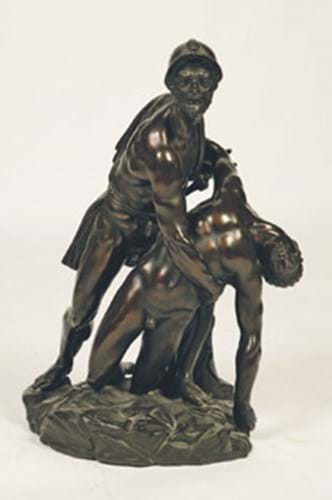
But no such razzamatazz accompanied the best seller in their next auction which took place last month.
There were few clues in the brief and basic catalogue entry which described it as "a 19th century French cast bronze sculpture of a warrior wearing a classical helmet, loose gown and sword holding a dying man in his arms on a rockwork base".
Equally there was little hint of promise in the £2000-4000 estimate.
Nonetheless, the 20in (51cm) high sculpture proved to be the sale's highlight when it sold for £110,000 (plus 17.5 per cent buyer's premium) making it far and away the most expensive of the 1000-odd lots offered on June 7-8.
It was the amount of pre-sale interest that this seemingly unassuming entry generated that hinted it was going to be the one to watch with hopes of somewhere around the £30,000-50,000 being subsequently entertained.
On the day, UK and overseas competition took the bidding to £50,000 after which it was a battle between two telephone bidders that sent it up to the final six figure price.
The bronze is in fact based on a known classical prototype and the general consensus about its more specific attribution leaned towards a Florentine origin. The Tuscan sculptor Ferdinando Tacca has been cited by some specialists as a prime candidate although a French origin has apparently not been ruled out.
The main clue lies in the work's form and subject. The bronze is a version of the classical group of Menelaus and Petroclus known as the Pasquino, which exists in several Roman marble versions.
One of these, now in Loggia dei Lanzi in Florence, was brought to the city from Rome by Cosimo de Medici, Grand Duke of Tuscany in 1570. A model for its restoration was produced in the early 17th century by Ferdinando's father Pietro Tacca, who was court sculptor to the Medici.
Back in January 1995, Sotheby's offered a very similar 22in (51cm) high Pasquino bronze from the collection of the well-known works of art dealer Cyril Humphris. This was attributed to Pietro Tacca and sold for $40,000 (£25,640) against predicted guidelines of $100,000-150,000.
The patination on the Humphris bronze was, say Duke's, somewhat different from their version which was darker and it was this, combined with characteristic features of Ferdinando's work like the broad surface treatment and the swirling punched decoration of the ground, that has prompted expert opinion to suggest authorship by the younger Tacca.




